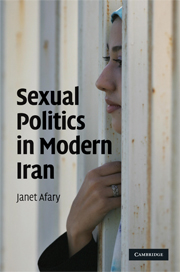Book contents
- Frontmatter
- Contents
- List of illustrations
- Acknowledgments
- Map of Iran
- Introduction
- Part 1 Premodern practices
- Part 2 Toward a Westernized modernity
- 4 On the road to an ethos of monogamous, heterosexual marriage
- 5 Redefining purity, unveiling bodies, and shifting desires
- 6 Imperialist politics, romantic love, and the impasse over women's suffrage
- 7 Suffrage, marriage reforms, and the threat of female sexuality
- 8 The rise of leftist guerrilla organizations and Islamist movements
- Part 3 Forging an Islamist modernity and beyond
- Conclusion: Toward a new Muslim-Iranian sexuality for the twenty-first century
- Glossary
- Bibliography
- Index
4 - On the road to an ethos of monogamous, heterosexual marriage
Published online by Cambridge University Press: 05 June 2014
- Frontmatter
- Contents
- List of illustrations
- Acknowledgments
- Map of Iran
- Introduction
- Part 1 Premodern practices
- Part 2 Toward a Westernized modernity
- 4 On the road to an ethos of monogamous, heterosexual marriage
- 5 Redefining purity, unveiling bodies, and shifting desires
- 6 Imperialist politics, romantic love, and the impasse over women's suffrage
- 7 Suffrage, marriage reforms, and the threat of female sexuality
- 8 The rise of leftist guerrilla organizations and Islamist movements
- Part 3 Forging an Islamist modernity and beyond
- Conclusion: Toward a new Muslim-Iranian sexuality for the twenty-first century
- Glossary
- Bibliography
- Index
Summary
At the turn of the twentieth century, Iran's population stood at around 10 million, with 200,000 in Tehran. Ninety-five percent of the population was illiterate. Average life expectancy remained under thirty due to high infant mortality, scarcity of health and hygiene facilities, and famine. Although little internal migration took place from rural to urban areas, several hundred thousand Iranians were living abroad in Russia and neighboring countries, often as migrant workers (Bharier 1971, 4–5, 26). In addition to these influences from abroad, through merchants and migrant workers, Western culture was spread through new educational institutions. These included missionary schools founded by American Presbyterians, secular Western ones formed by the Alliance Française and Alliance Israélite Universelle, Baha'i schools, other Iranian schools, and the first modern institution of higher learning, the Dar al-Fonun, which was formed in the mid-nineteenth century (Arasteh 1969, 164; Nikbakht 2002, 200; Ringer 2001; Shahvar 2008).
It was in this period that three broad and overlapping political discourses on gender and modernity emerged in elite urban circles. (1) A new nationalist discourse of “scientific domesticity” embraced modernity in the areas of health, hygiene, and education. It emphasized industrialization, education, and new health measures that improved standards of living, reduced child mortality, and gave women greater authority within the home, all with the aim of turning Iran into a modern country. Most proponents of this view did not want to radically alter existing gender or sexual patterns or question the shariʿa in terms of family and personal law.
- Type
- Chapter
- Information
- Sexual Politics in Modern Iran , pp. 111 - 141Publisher: Cambridge University PressPrint publication year: 2009



